
Definition and terminology in accordance with Andersen et al. 1975: 16-19. The surface of most core axes is fully covered by negative removals.Core axes may be made on flakes and have parts of the flake's original surface, but if so, this is not part of the edge of the artifact. In the opposite case the artifact is classified as a flake axe. The edges of core axes must be made by edge removals and/or removals from the edge towards the neck.

Daggers are often made to resemble bronze daggers - and probably used as ritual or status objects rather than as tools or weapons. Evidence from use-wear analysis suggests this (see Grace 1990).
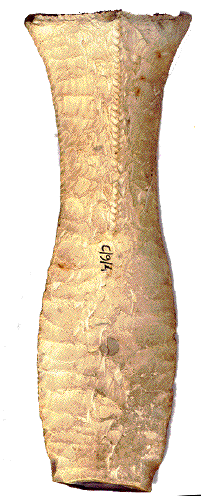
Scrapers that are made on the end of a flake or blade. The retouched end may be the proximal end or the distal end, but the vast majority of end scrapers are made on the distal end, as this does not require the removal of the bulb of percussion.End scrapers are further defined by the shape of the retouched end, being either concave, straight or convex.
When an end scraper has been made on a flake that is wider than it is long, it is sometimes referred to as a transverse scraper.
An end scraper which has a retouched end that is convex in form.
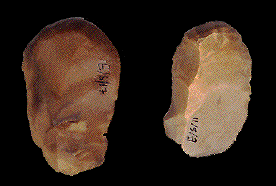
endscrapers on flakes
Scrapers that are made on the side of a flake or blade. The retouched side may be the left edge or the right edge, or even on both in which case it would be called a double side scraper. Side scrapers are further defined by the shape of the retouched edge, being either concave, straight or convex. Side scrapers may be made on blanks that are blades or flakes.
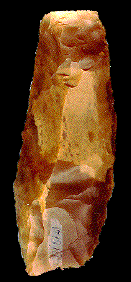
Bifacially retouched points are projectile points that are retouched on both surfaces, often with invasive retouch covering most of both surfaces. They are divided into types by shape, e.g. bifacial leaf-shaped point,bifacial, triangular point, bifacial lanceolate point. They may be tanged or have barbs, or both, as in a bifacial barbed and tanged point.
Bifacial leaf-shaped points are bifacial projectile points that are retouched on both surfaces and shaped like a leaf.
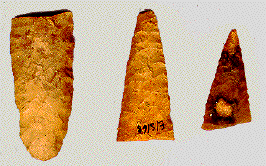
Tanged points are projectile points that have a tang at one end to facilitate hafting. A tang is made by retouching one or, more usually, both edges, in order to create a projection that is thinner than the width of the blank. This projection is then fitted into the arrowshaft.
Tanged point - A1 are projectile points that are made from naturally pointed blade blanks that have little or no retouch, except for the tang which is created by direct retouch (see Helskog et al. 1976: 26)
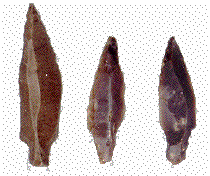
©
Internet Archaeology
Last updated: Thu Mar 20 1997